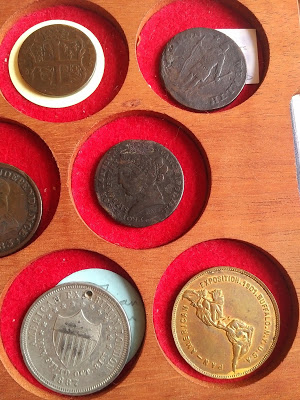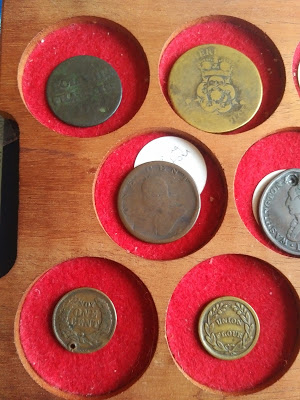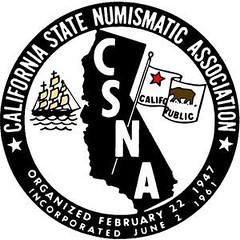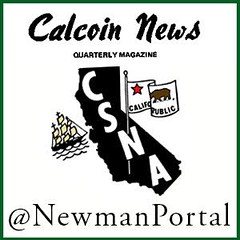
David Pickup shared this post from the Oxford Numismatic Society blog, published yesterday. Thanks! Interesting to see what American coins and tokens are available across the pond.
-Editor
 
The March meeting was on the coins of the USA. here are some coins members brought along.
American coins
A1 French Coinage for Canada and Louisiana:
In 1721-1722 the mints at Rouen (mintmark B) and La Rochelle (mintmark H) produced a copper nine deniers coin for the colonies using copper planchets imported from Sweden. In the summer of 1722 over
a half million (534,000) nine deniers coppers were shipped to Canada. Canadians disliked this coin because it was underweight and was not accepted in the British colonies.
A2 Rosa Americana Tokens 1722-1724:
William Wood, owner of several copper and tin mines, hoped to make a profit producing coins for use in Ireland and America. The coins were made of an alloy called Bath metal composed of 75% brass,
20% zinc (mixed with tin and bismuth) and 5% silver and were to weigh slightly less than half the weight of English coins. Wood produced twopence, penny and halfpenny coins dated 1722-1723. These
underweight coins were not generally accepted by the colonists.
A3 The Virginia Halfpenny of 1773:
These coins, designed by Yeo, were made at the Tower mint in London. The Revolution broke out just before they were not used until after the war. The halfpenny displays the bust of George III on the
obverse with the shield of Virginia on the reverse.
A4 Massachusetts 1787 cent produced locally
B1 The Washington Double Head Cent Token:
This is one of four interrelated Washington tokens of which three bear the date 1783 and two have the designation of "ONE CENT". The Military Bust token was designed by Thomas Wells Ingram
and was struck at Bolton's Soho Mint in Birmingham, England between 1820 and 1848, with the 30's or 40's appearing more likely as the token was still in circulation at mid century. Little
is known about the Double Head token. It is usually considered to be an imitation of the military bust by an unidentified Birmingham mint.
B2 Washington Military Bust Tokens:
The obverse depicts a laurel wreathed bust facing left in a military uniform with the legend "WASHINGTON AND INDEPENDENCE" and the date 1783 commemorating the end of the Revolutionary War.
Clearly, the bust is meant to represent George Washington. However, the central bust punch used for this series was originally produced and used for the Wellington peninsular tokens. They were
ordered by J. Picard of Hull from the Birmingham factory of the button and medal maker Sir Edward Thomason. The Wellington tokens were struck at Thomason's press with dies and punches cut by
Thomas Halliday, a die-sinker located on Newhall Street in Birmingham.
B3 Merchant token 1850s
Bust of Liberty left, LIBERTY on tiara, PROFESSOR. JOHNSON'S. SOAP & STARCH POLISH. around, 317.BOWERY.N.Y. curves in front of portrait. Rv. Federal-style eagle, FOUNTAIN. BLACKING BRUSH & FRENCH
BLUEING around, UNITED. STATES. arcs above eagle's head.
C1 Not one cent
This is an unofficial Civil war period token
C2 And a store token C3
The American Exhibition was a world's fair held in West Brompton London, in 1887 in the year of Queen Victoria's golden jubilee.
Support for an exhibition had been sought in 1886, but with a loss of support and the British government insisting that an American exhibition not compete with the Colonial and Indian Exhibition,
the American Exhibition was deferred to 1887. The American aim of participating was to display the latest agricultural, mechanical and textile products and inventions from the United States, but the
main attraction was the Wild West show featuring Buffalo Bill, part of Colorado's contribution
C4 American exhibition
The Pan-American Exposition was a World's Fair held in Buffalo, New York, United States, from May 1 through November 2, 1901. The fair occupied 350 acres (1.4 km2) of land on the western edge of
what is now Delaware Park, extending from Delaware Avenue to Elmwood Avenue and northward to Great Arrow Avenue. It is remembered today primarily for being the location of the assassination of
President William McKinley.
To read the complete article, see:
http://oxfordnumismaticsociety.blogspot.co.uk/
Newman Numismatic Portal Partner of the Week
 
Wayne Homren, Editor
The Numismatic Bibliomania Society is a non-profit organization
promoting numismatic literature. See our web site at coinbooks.org.
To submit items for publication in The E-Sylum, write to the Editor
at this address: whomren@gmail.com
To subscribe go to: https://my.binhost.com/lists/listinfo/esylum
Copyright © 1998 - 2024 The Numismatic Bibliomania Society (NBS)
All Rights Reserved.
NBS Home Page
Contact the NBS webmaster
| 




